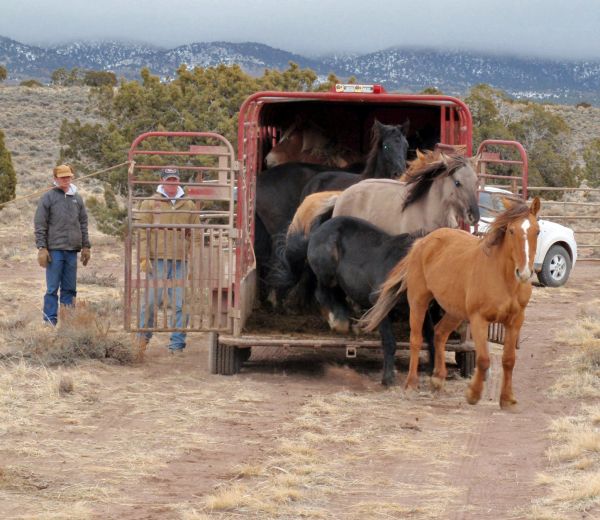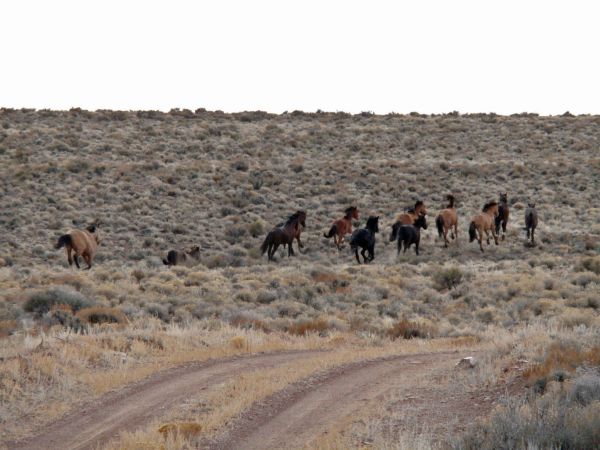
CEDAR CITY – About 100 wild horses are slated to be rounded up in Iron and Beaver counties Tuesday, one of several roundups conducted since 2014 to try and bring the overwhelming herd numbers under control.
The Bureau of Land Management will be removing the wild horses from areas within and outside the Bible Spring Complex located in both counties.
Under federal law, the BLM is tasked with keeping the population of wild horses within Herd Management Areas to a specific number referred to as an Appropriate Management Level. For the Bible Springs Complex HMA, the AML is set at a minimum of 30 head and a maximum of 60.
Herd Management Areas were set up under the Wild Free-Roaming Horse and Burro Act of 1971 as lands under the BLM’s supervision primarily managed for the exclusive benefit of “wild horses and burros.” There are approximately 270 HMAs across 10 states comprising 31,600,000 acres. The complex encompasses the Four Mile, Tilly Creek and Bible Springs herd management areas.
In 2014, Iron and Beaver County commissioners threatened the BLM they would take care of the issue themselves if the agency did not begin efforts to reduce what was then estimated at 2,000 wild horses on the range in their region.
The BLM has since held several roundups within the Bible Springs area cutting population numbers down to what is now around 600 wild horses, a number that county commissioners say is still too high.

“The roundups have reduced the numbers but they are still way too high,” Iron County Commissioner Alma Adams said. “We just have to find a way to take care of this issue. Right now, they round them up and then they release back on the range and then the numbers increase again. It’s a vicious cycle that just goes round and round. Our congressmen have done a lot to try and get this issue settled but they haven’t been able to do anything yet so we’re still in the same position we were really four years ago.”
Congressman Chris Stewart has continued to try and address the wild horse issue with various pieces of legislation. The most recent, approved in July in the House Appropriations Committee, was an amendment to the Interior Department’s annual appropriations bill that allows the BLM to kill “healthy, unadopted wild horses” in their care.
“Wild horses are having a severe impact on Utah’s lands,” Stewart said in a news release last month. “They are destroying the range and in many instances are starving to death due to lack of feed and water. At the same time, they are harming native vegetation and displacing native deer and elk. We can’t keep this up, especially when you consider the long-term costs of managing horse populations. If you love horses like I do, we need to fix this.”
The BLM is currently responsible for overseeing approximately more than 73,000 wild horses and burros that inhabit the rangelands and nearly 50,000 in BLM corrals waiting for adoption to the tune of more than $1 billion annually, Stewart’s news release stated.
BLM officials, however, say they are committed to managing the herd growth and continue to work to bring herd numbers to those allowed by law.
“The BLM is committed to maintaining a healthy wild horse population and healthy rangelands in the Bible Springs Complex Herd Management Area,” BLM Cedar City Acting Field Manager Paul Briggs said. “By managing herd growth, we are ensuring enough food and water is available for the wild horses, while at the same time protecting public rangeland resources and reducing conflicts with private land owners.”

The animals removed from the range will be made available for adoption through the BLM’s Wild Horse and Burro Adoption Program. Those that are not adopted will be cared for in long-term pastures.
The public is welcome to observe daily operations through BLM escorted tours – provided the safety of the animals, staff and observers are not jeopardized and operations are not disrupted. Observers must provide their own transportation, water and food. No public restrooms will be available.
The BLM recommends weather-appropriate footwear and neutral-colored clothing. Binoculars and four-wheel drive and high clearance vehicles are also strongly recommended. Those interested in participating should meet at the Maverik Adventure’s First Stop, 220 N. Airport Road in Cedar City, where tours will depart at 5 a.m. Details will be announced daily on the BLM gather hotline, telephone 801-539-4050.
Visitors and observers to the gather area should be aware that low flying helicopters will be used as part of the operation. Flying Unmanned Aerial Vehicles (drones) near the Wah Wah and Indian Peak Mountain ranges will be prohibited during the gather. Brief road closures may also be needed to allow movement of horses during gather operations.
Gather updates and information will be posted at the BLM website. Anyone interested can get updates on Twitter by following @BLMUtah or searching #BSCGather on Twitter. To learn more about the wild horse and burro program or to obtain an adoption application, visit the BLM National Wild Horse and Burro website.
Details on the Environmental Assessment for this gather are available on the BLM website
For more information, contact Public Affairs Specialist Lisa Reid at 435-743-3128 or [email protected]. Persons who use a telecommunications device for the deaf, or TDD, may call the Federal Information Relay Service, or FIRS, at 800-877-8339 to leave a message or question for Reid. The FIRS is available 24 hours a day, seven days a week. Replies are provided during normal business hours.
The BLM manages more than 245 million acres of public land, the most of any Federal agency, it news release states. This land, known as the National System of Public Lands, is primarily located in 12 Western states, including Alaska. The BLM also administers 700 million acres of sub-surface mineral estate throughout the nation. The BLM’s mission is to sustain the health, diversity, and productivity of America’s public lands for the use and enjoyment of present and future generations. In Fiscal Year 2015, the BLM generated $4.1 billion in receipts from activities occurring on public lands.
Email: [email protected]
Twitter: @tracie_sullivan
Copyright St. George News, SaintGeorgeUtah.com LLC, 2017, all rights reserved.
My hope is the BLM exercises compassion and care in rounding up and caring for these horse. Far too often the process is cruel and brutal; unacceptable.
First it was Starvation.
Next it was Climbing numbers of horses
Next it was interfering with traffic
Next it was they are starving out cattle
Then it’s All the Wild Horses are Feral
Then they are all weak skin and bones
Then it’s their on ranchers private lands
So when all else fails admit they want to male a profit at slaughter,
Then when that fails you say you just want to kill these healthy horses period
Can I ask exactly when do quit lying?
When do you actually think real American s ate going to believe this small population of horses especially those in holding were Not and are Not eating the Entire range? Do you think America is so stupid we cannot estimate the total acreage all the combined horses minus those in holding are consuming? And that we cannot figure out that your lying? The average horse consumes less than the average domestic caught horse. They also only have so much area they consume in at a time because horses move as they graze.
Last I am really shocked that your not smart enough to know we can not only calculate the mass and volumn consumption of all the combined horse numbers minus the horses in holding not eating the range and figure the Entire product amount every horse needs to survive and then use current data on forage to calculate the percentage of their consumption in the Entire millions of acres BLM lands and are for ourselves your lying. By the way. To the Ranchers who keep saying people in other states don’t know….simply put it this way we had Ranchers in Your States who partipated in a study to figure how much consumption wild horses vs cattle takes place on the range. Given specified areas, in your climates, given 6 months to complete their own survey of the results, given the exact number of horses to cattle ratio to level out claims horses consume more and even with all herds maintaining less cattle than horses, the cattle all came in as Consuming MORE THAN THE HORSES. The cattle cleared the ares they given. The horses had forage left over. This is in comparison to our study we completed in the Central States where horses outnumbered cattle and cattle depleted the largest pastures and horses still had grazing left in every location. The location has nothing to do with consumption. The cattle in your climate or ours putconsumed the horses which outnumbered the cattle, given the exact same pasture size, same forage scenario, water availability and opportunity to graze was 24/7 all weather. So I personally am tired of the lies. The horses are Not and have Not consumed more ever. The devastation is from The vehicles in the pictures constantly driving everywhere on public lands creating dust bowls. There’s a plethora of lies to slaughter horses. That’s all this is above. Call Congress and say No way
This is a drop in the bucket. The 2016 Indian Peaks Range mustang count was approx. 1800 horses. The given land studies show it will support 700.
So they should remove 1100 for the whole range. Put them to good use like the elk and deer which serve a good purpose. The area is obviously a great breeding ground for mustangs, but they’re over running the entire range. So far it’s complete mis-management due to cowering to the ignorant.
There are only five Spanish herds in the U.S., and the Sulpur herd is one of them. These horses should be preserved, as should all wild horses in the U.S. https://www.blm.gov/site-page/programs-wild-horse-and-burro-herd-management-herd-management-areas-utah-sulphur-hma
We presently have about 1% or 2% of our native wild horses left on this earth in the United States, so we must protect them as well. Just prior to WWI, we had over 2 million. Many were exported for war and died alongside our marines and army, fighting for our freedom. These are our war heros.
I’ve driven all over the back country in the western states and I’ve never seen more than a dozen wild horses together in one place. I also see very few cattle together in mostplaces. I have seen a lot of open range with nothing grazing on it at all except an occasional deer or antelope herd. So this article doesn’t make sense. Mustangs are usually small horses. Leave them alone.
“Range land resources” meaning cattle grazing. This is for those who graze their cattle on public lands, including those like Bundy who do not pay for the grazing rights. The horses actually eat less than the cattle do. I pay for public land use. Since I do not traipse all over the lands (I physically cannot) I let the horses do it for me. Therefore please do not round up my horses and kill them.